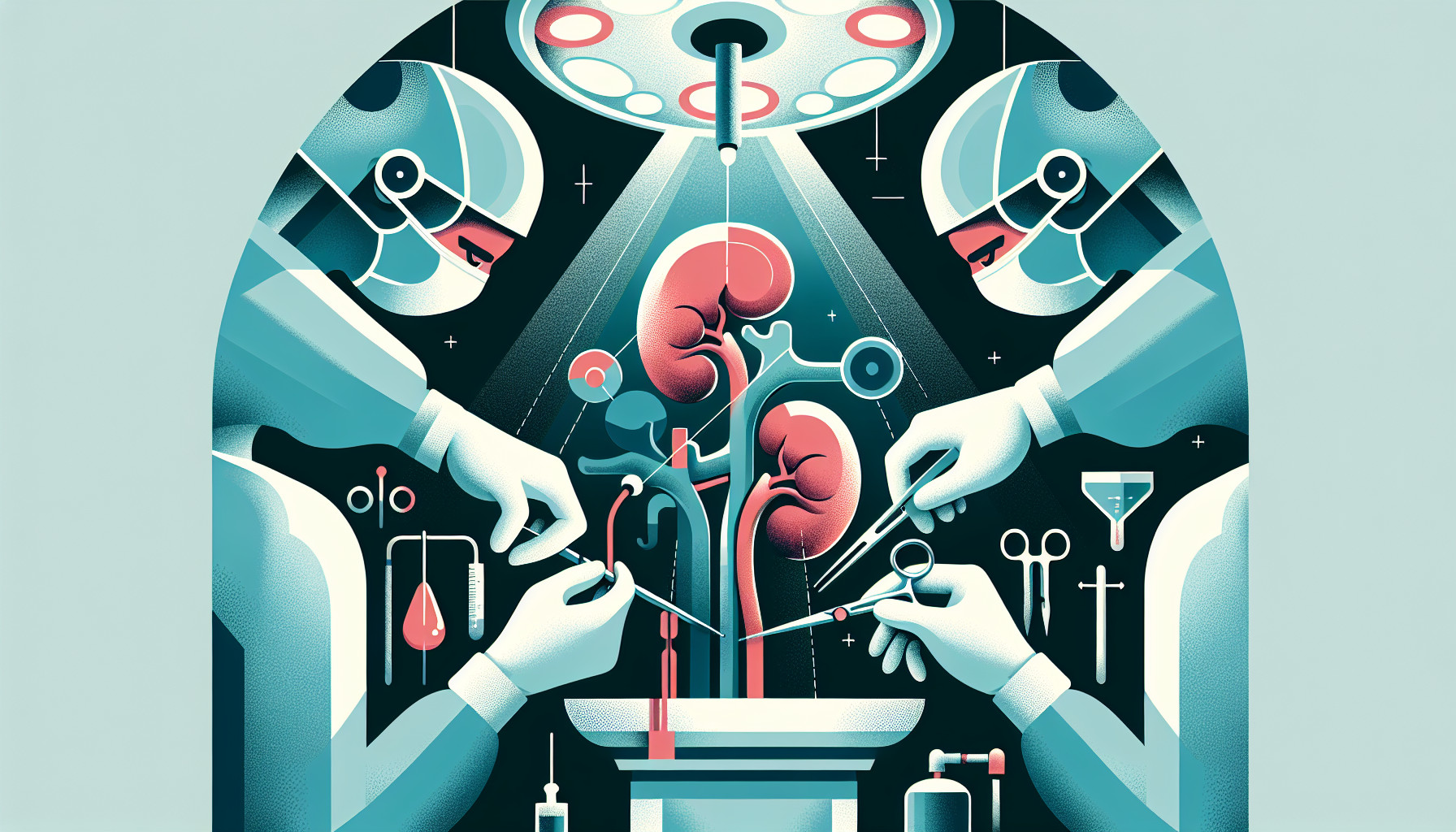Our Summary
This research paper discusses a new surgical technique for kidney removal in patients suffering from a disease called autosomal dominant polycystic kidney disease. This disease often results in large kidneys, which can be problematic during surgery. The authors of the paper have developed a technique called hand-assisted laparoscopic nephrectomy (HALN) which allows for the removal of these large kidneys through a less invasive procedure than traditional open surgery.
The authors compared the results of 26 surgeries using HALN to 22 surgeries using the traditional open surgical technique. They found that the HALN technique took longer, but there was no significant difference in complications during or after surgery. Additionally, the length of hospital stays were similar for both techniques.
The main conclusion is that the HALN technique is a safe and effective method for removing large kidneys in patients with this disease. It takes a bit longer than traditional surgery, but there are no extra risks and patients experience less pain and discomfort after surgery.
FAQs
- What is hand-assisted laparoscopic nephrectomy (HALN)?
- How does the HALN technique compare to the traditional open surgical technique in terms of time, complications, and post-surgery recovery?
- Is the HALN technique a safe and effective method for removing large kidneys in patients with autosomal dominant polycystic kidney disease?
Doctor’s Tip
A helpful tip a doctor might tell a patient about laparoscopic nephrectomy is to expect a slightly longer surgery time compared to traditional open surgery, but that the procedure is safe and effective with minimal risks and quicker recovery time. Patients can also expect less pain and discomfort after the surgery.
Suitable For
Patients who are typically recommended for laparoscopic nephrectomy include those with autosomal dominant polycystic kidney disease, as discussed in this research paper. Additionally, patients with kidney cancer, kidney stones, kidney cysts, or other kidney diseases may also be candidates for this procedure.
Laparoscopic nephrectomy is generally recommended for patients who are in good overall health and do not have extensive scarring from previous surgeries. Patients with a single functioning kidney, severe obesity, or certain medical conditions that make open surgery more risky may not be suitable candidates for laparoscopic nephrectomy.
Overall, laparoscopic nephrectomy is a minimally invasive surgical option that can result in less pain, faster recovery times, and shorter hospital stays compared to traditional open surgery. It is important for patients to discuss their individual medical history and condition with their healthcare provider to determine if laparoscopic nephrectomy is the best treatment option for them.
Timeline
Before laparoscopic nephrectomy:
- Patient is diagnosed with autosomal dominant polycystic kidney disease and is recommended for surgery due to complications such as pain, infection, or kidney function decline.
- Patient undergoes pre-operative testing and evaluations to assess their overall health and suitability for surgery.
- Patient is informed about the laparoscopic nephrectomy procedure, its benefits, risks, and potential outcomes.
- Surgery date is scheduled and patient prepares by following specific pre-operative instructions such as fasting and medication adjustments.
After laparoscopic nephrectomy:
- Patient arrives at the hospital on the day of surgery and undergoes the laparoscopic nephrectomy procedure under general anesthesia.
- Surgeon makes small incisions in the abdomen and inserts a laparoscope and surgical instruments to remove the affected kidney.
- Surgery typically takes longer than traditional open surgery, but is less invasive and results in smaller incision scars.
- Patient is monitored in the recovery room post-surgery and may stay in the hospital for a few days for observation and pain management.
- Patient is discharged from the hospital once they are stable and able to manage their recovery at home.
- Patient follows post-operative care instructions provided by their healthcare team, including pain management, wound care, and activity restrictions.
- Patient attends follow-up appointments to monitor their recovery, kidney function, and overall health.
What to Ask Your Doctor
Some questions a patient should ask their doctor about laparoscopic nephrectomy include:
- What are the potential risks and complications associated with the surgery?
- How long is the recovery period after laparoscopic nephrectomy?
- Will I need to make any lifestyle changes or follow a special diet after the surgery?
- How experienced are you in performing laparoscopic nephrectomy procedures?
- What are the alternatives to laparoscopic nephrectomy for my condition?
- Will I need any additional tests or evaluations before the surgery?
- How long will the surgery take and how long will I need to stay in the hospital?
- What type of anesthesia will be used during the procedure?
- How will my pain be managed after the surgery?
- What are the long-term outcomes and potential benefits of laparoscopic nephrectomy for my specific condition?
Reference
Authors: Collini A, Benigni R, Ruggieri G, Carmellini PM. Journal: JSLS. 2021 Jan-Mar;25(1):e2020.00107. doi: 10.4293/JSLS.2020.00107. PMID: 33879988
